When visiting this Paris museum, it is very common to start with the Louvre Highlights, among them, the salle des Etats, It is nestled deep within the Louvre, serving as the destination for every visitor, for at its very epicentre lies the most famous painting in the world.
Mona Lisa was created based on Lisa Gherardini, the wife of a Florentine silk merchant, brought to life on canvas with Leonardo da Vinci’s incredible sfumato technique. What has made her past much more interesting is her value as art – the pricelessness that led to an incredible heist when, on 21st August 1911, the Mona Lisa was stolen, not to be found until two years later.
Not only does the best museum in the world boast the most famous woman’s enigmatic smile, but countless other priceless artworks are also displayed alongside Leonardo da Vinci’s masterpiece, filling up one of the larger rooms in the Palace. Opposite the Mona Lisa hangs the Wedding Feast of Veronese at Cana, magnificent in all its glory and surrounded by works like Pastoral Concert and Man with a Glove by Titian and even Tintoretto’s The Coronation of the Virgin (AKA Paradise), albeit the sketch alone as the original refers to the decorative scheme for the Sala del Maggiore Consiglio in Venice.
Other famous paintings in Louvre Museum’s Salle des Etats include the Portrait of a Venetian Woman (La Bella Nani) and Supper at Emmaus by Veronese, Man with a Glove by Titian, and more.
But, while a description of Salle des Etats without mentioning these masterpieces is impossible, it is equally impossible not to mention the room’s history. After all, as all great architects say, architecture, too, is art.
Designed by the great Hector Lefuel, the Salle des Etats was built sometime between 1855 and ’57 and, beyond art, has a history of having hosted legislative meetings by Napoleon III during the Second Empire. Only after his fall from power did this room become part and parcel (and the most famous destination) of the best museums in the world, hosting some of the greatest of Louvre collections of Venetian Paintings and beyond.
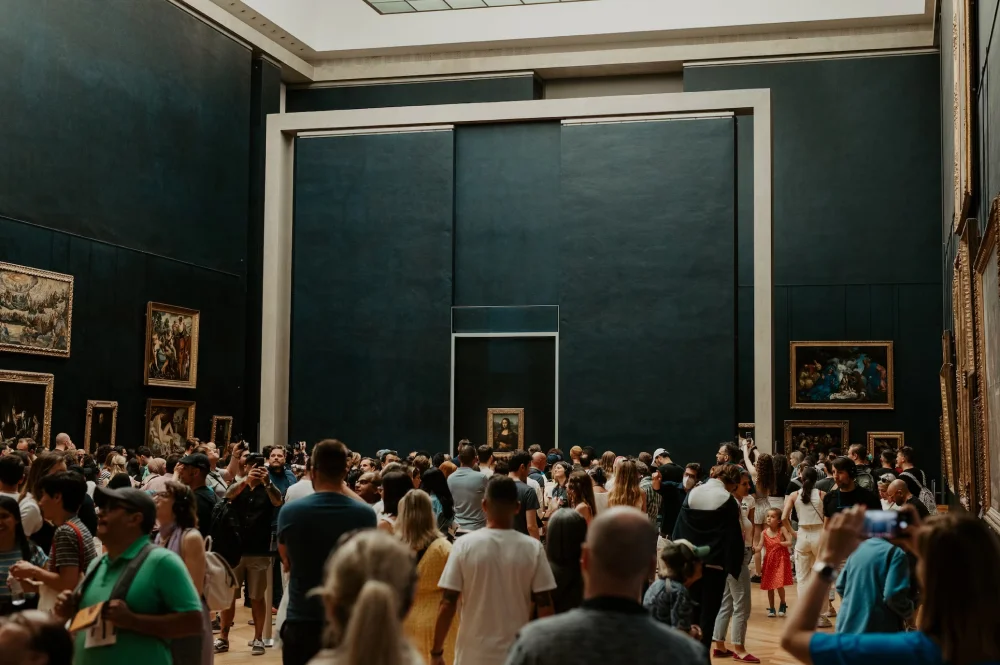
The Louvre collection of sculptures and statues brooks no contest, for the symphony of form and beauty placed throughout the Palace is the best in the world.
They showcase the mastery of sculptures throughout history, imbue a third dimension into art, and stand proud and eternal within the halls of the best museum in the world.
Indeed, the Winged Victory of Samothrace is one of those very sculptures, likely one the most famous and one of the most visited, capturing the essence of victory in motion through Hellenistic artistry.
It stands on the Daru staircase on the Denon Wing, a truly incredible likeness of a ten-foot tribute to Nike, the goddess of victory.
The Venus de Milo sculpture is just as popular (and, for others, more) and stands as one of the world’s most iconic sculptures.
Discovered in 1820 on Milos, the statue is a depiction of the Greek and Roman goddess of love and beauty. People refer to her as the work of Alexandros of Antioch.
Other magnificent Louvre sculptures include Diana of Versailles (1st Century), Venus of Arles (1st Century), and even Michelangelo’s Dying Slave & Rebellious Slave (1513).
Fun fact – the Louvre collection owes the French Revolution for the ownership of the endless sculptures within the Palace halls, for the revolution caused the mass confiscation of art and treasures from the aristocracy hoarding what are now purely public Louvre sculptures.
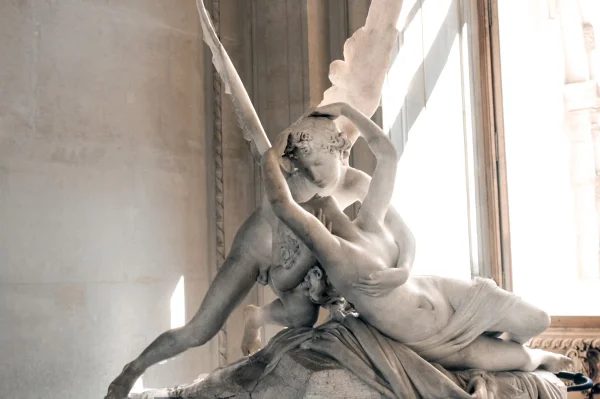
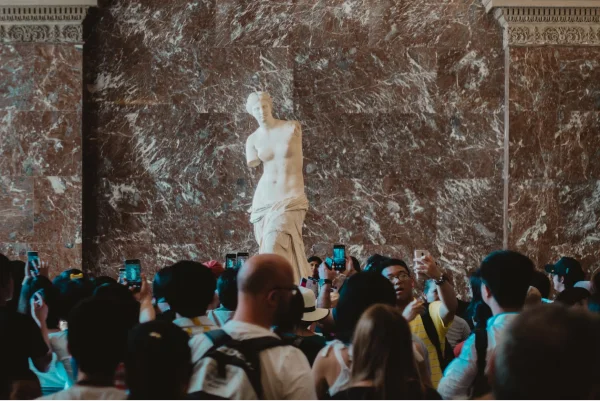
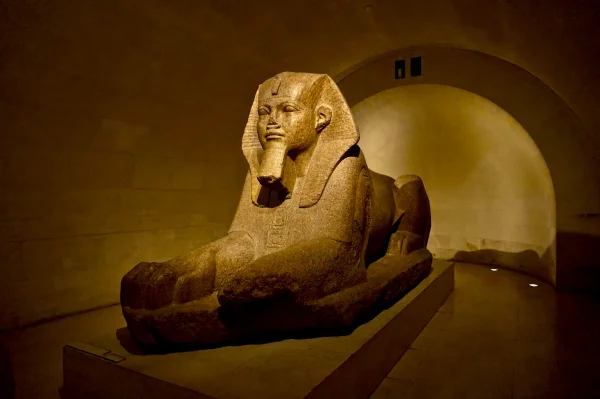
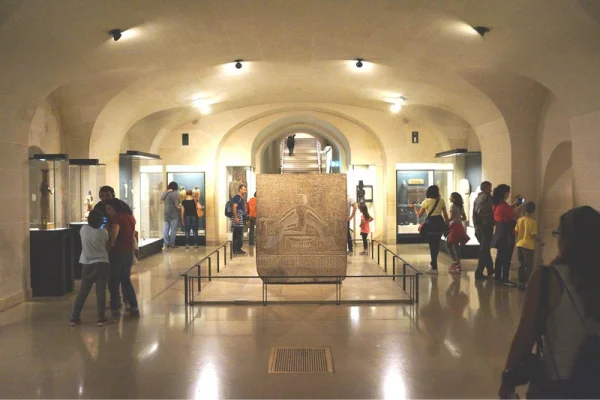
Egypt has long held the world’s fascination, and when you consider art and antiquities, one of the greatest collections of tribute to this incredible country can be found within the Louvre Museum Egyptian collection.
The art found within these walls becomes a gateway to Ancient Egypt through the Louvre’s endless dedication to preserving the wonders of ancient civilizations.
Today, Louvre’s Department of Egyptian Antiquities occupies two floors, categorically relegating the display on the daily lives of Ancient Egyptians to the lower floor and the chronological display on Ancient Egypt (till the Ptolemaic Period) to the second level.
One of the greatest features of this Louvre collection is the Great Sphinx of Tanis, which was discovered in the Eastern Delta of Lower Egypt.
A massive creation, it was acquired by the Louvre in 1826 and has reframed Egyptian mythology to become one of the most well-known creatures of history and mythology. It is presently located in the crypt created by Albert Ferran.
The statue of Horus from the Posno collection also deserves mention within these lines, for being discovered within the Memphis region, it has allowed history to fill in the gaps of religion and the gods and is a tribute to the Egyptian god of kingship, healing, and more.
There are other masterpieces within these hallowed halls, like the Sekhmet statue, the Gebel el-Arak knife, a Mummy of a man wrapped with cartonnage, and the coffin of Lady Madja, to name a few.
In short, your journey through the Louvre Museum Egyptian Collection is a tour through time and mythology, and it allows you to glimpse the daily lives, religious practices, and profound beliefs of ancient Egyptians.
The Grande Galerie is a wing of the Louvre Palace once known as the Galerie du Bord de l’Eau. As one of the most iconic rooms in the Louvre, this is indeed the longest room in the Palace. It was completed in 1607, linking two palaces – the Louvre and the Tuileries.
It was constructed by the architects Louis Métezeau and Jacques Androuët du Cerceau, and it was under Louis XIV that this vast gallery began to display works of art. But the design of the gallery must be attributed to Hubert Robert, whose majestic painting, Design for the Grand Galerie, is not to be missed.
Home to Italian Paintings and art, this gallery is a testament to Italian culture, history, and wonderment, hosting other majestic features such as Leonardo Da Vinci’s La Belle Ferronnière, a portrait of a court lady from Milan, and Rafael’s Balthazar Castiglione.
There are other Italian paintings within this Louvre collection, an endless source of time travel and grandiose compositions, each telling a story ripe with art, innovation, and culture.

LOUVRE TICKETS
Skip the long queues and fast-forward your entry to the world’s biggest and most iconic art museum. With Versailles…
LOUVRE PLACES
The Louvre entrance is not just one place or location but many. There are, in fact, four entrances you can utilise to…
LOUVRE HIGHLIGHTS
Louvre Highlights
Art is beauty, love, and persistence, and some artworks have, throughout the centuries, made indelible marks on the world..
